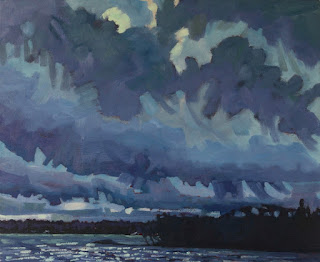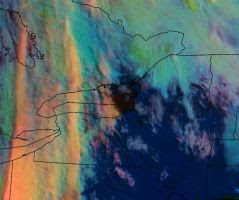 |
#2642 "March Hang Bag"
10x12 smooth panel oils |
The trailing edge of the cyclonic companion of the warm conveyor belt that comprises a storm is always the clear signal that the weather is about to pass.
 |
My View ( red arrow) looking westerly from under the last
remains of the cloud deck associated with the Cyclonic
Companion of the Warm Conveyor Belt
|
Colloquially this is called the "
hang back" portion of the storm as it appears well behind the central portion of the storm. A meteorologist I once worked with always confused this term with “
hang bag” as in shopping for weather. She passed shortly after retiring and I use her version out of remembrance.
The gravity waves embedded in this sheet of altostratus revealed that the winds in the free atmosphere were northwesterly and this is entirely consistent with the deformation zone. This portion of the deformation zone is typically as sharp as a knife for the same reasons that contrails are best defined on the edge from which the winds are blowing and are causing it to drift. The entire pattern including the clearing was moving toward the southeast.
There were still some streets of turbulent stratocumulus in the north-northwesterly boundary layer winds. They would dissipate with the sun.
If you look closely, you can also see some Langmuir streaks in the open water of Singleton Lake. The western basin of the lake was still ice covered although you would want to be wearing your bathing suit if you planned to walk on that surface. The male loon would judge that the ice was dissipated enough for him to return on April 1st, the day following this sunset .. and that is no joke.
The sun was below the western horizon but the last rays were still illuminating the underside of altostratus gravity waves which were in turn lighting up the wave crests of the lake. The sodden ice was not very reflective. If you paint what you see, the optics have to be scientifically correct. The weather is always interesting and we just need to take the time to appreciate what the clouds have to say.
I was using a lot of oils on a very smooth surface so the approach was to lay the correct colours in place and then leave them alone.
For this and much more art, click on Pixels. Thank you.




























